Management and Operations Analysis: Leadership Theories at Sainsbury's
VerifiedAdded on 2023/06/18
|23
|4134
|488
Report
AI Summary
This report analyzes the management and operations of Sainsbury's, a UK retail supermarket, focusing on the roles of managers and leaders and the differences between them. It examines various management theories, including contemporary, classical, behavioral, contingency, situational, and systems theories, evaluating their strengths and weaknesses in the context of Sainsbury's. The report highlights key operational areas such as marketing and human resource management, discusses operational approaches, and considers the impact of external factors on decision-making. It concludes with recommendations for improving operational efficiencies through effective leadership and management practices, emphasizing the importance of communication, employee engagement, and training for organizational success.
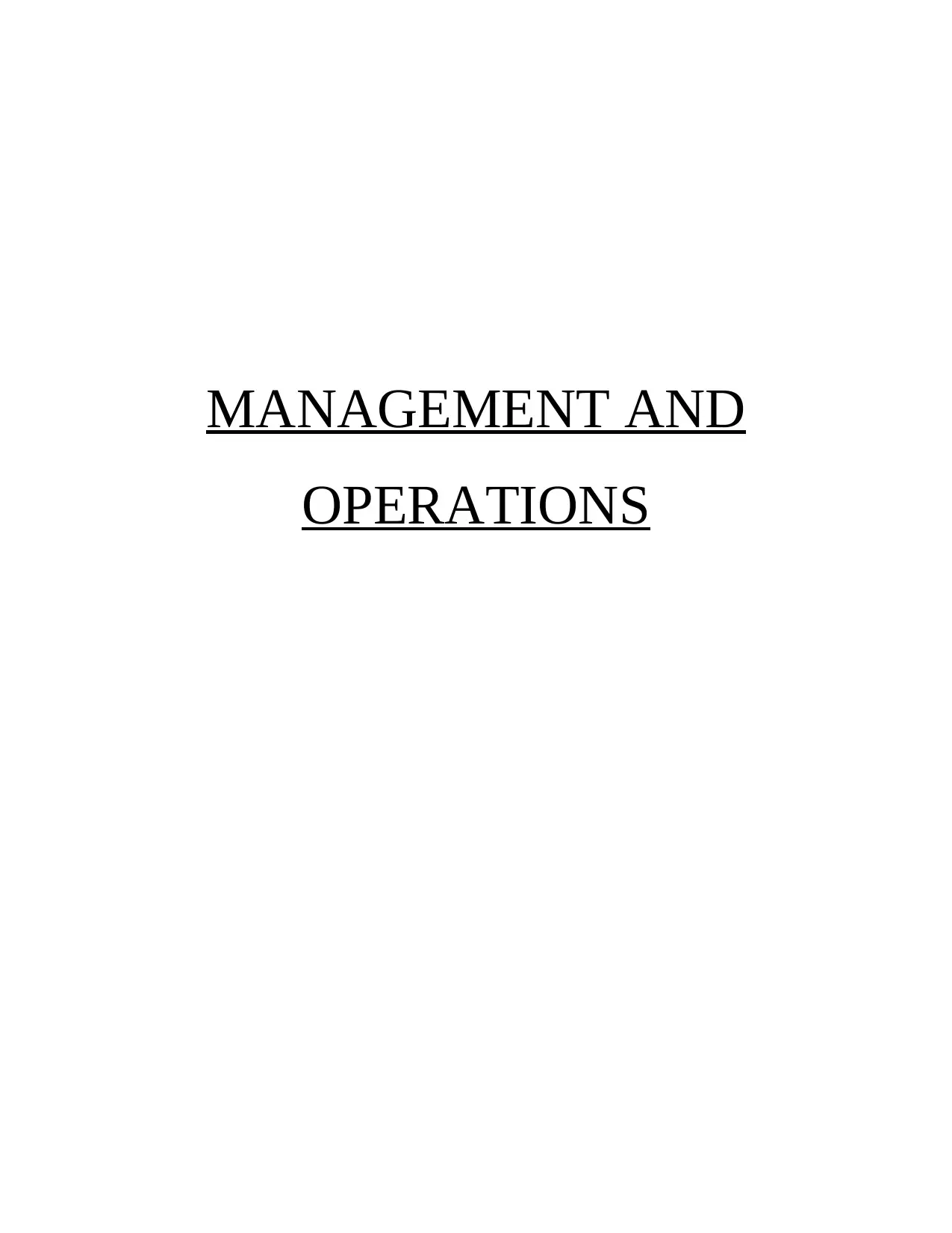
MANAGEMENT AND
OPERATIONS
OPERATIONS
Paraphrase This Document
Need a fresh take? Get an instant paraphrase of this document with our AI Paraphraser
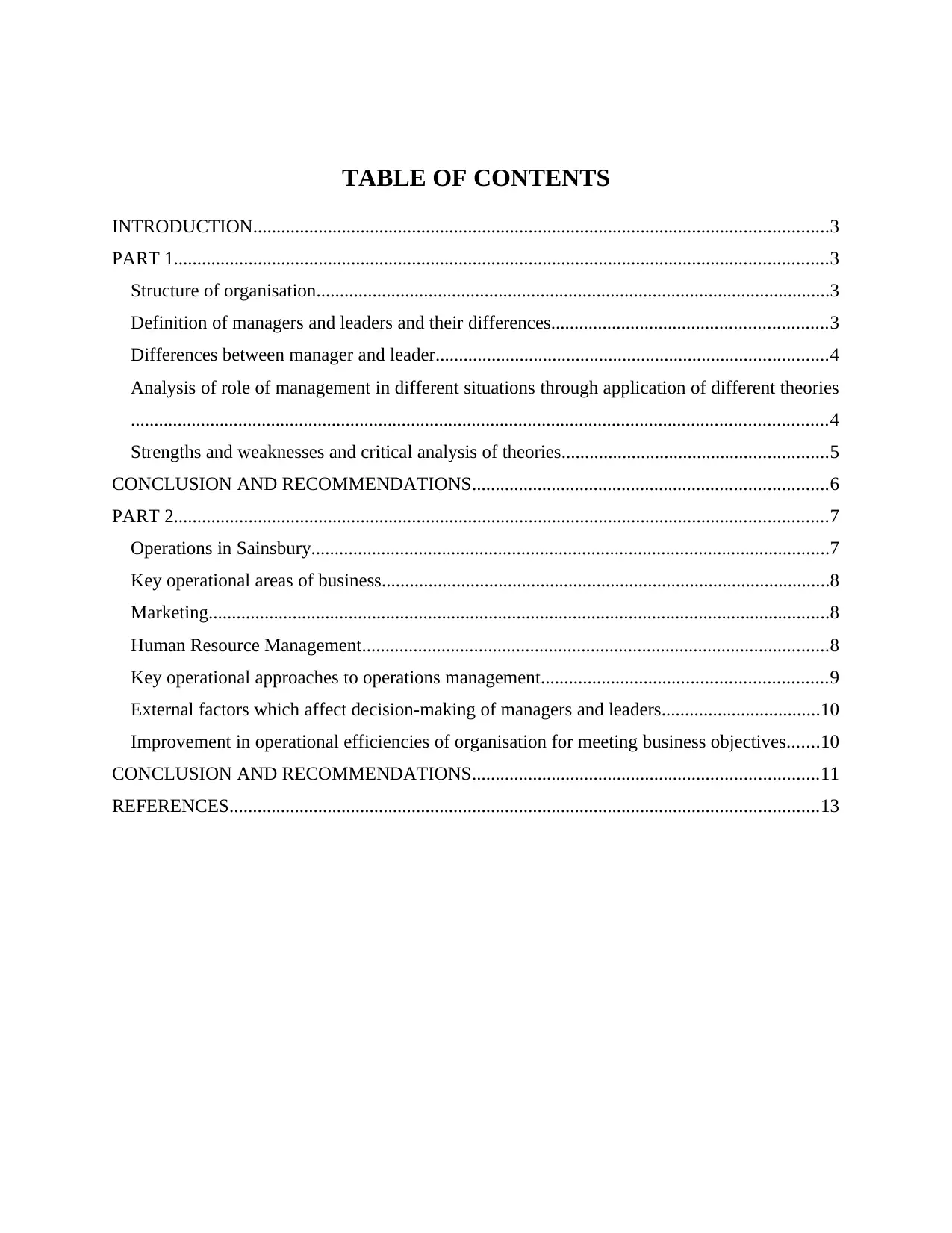
TABLE OF CONTENTS
INTRODUCTION...........................................................................................................................3
PART 1............................................................................................................................................3
Structure of organisation..............................................................................................................3
Definition of managers and leaders and their differences...........................................................3
Differences between manager and leader....................................................................................4
Analysis of role of management in different situations through application of different theories
.....................................................................................................................................................4
Strengths and weaknesses and critical analysis of theories.........................................................5
CONCLUSION AND RECOMMENDATIONS............................................................................6
PART 2............................................................................................................................................7
Operations in Sainsbury...............................................................................................................7
Key operational areas of business................................................................................................8
Marketing.....................................................................................................................................8
Human Resource Management....................................................................................................8
Key operational approaches to operations management.............................................................9
External factors which affect decision-making of managers and leaders..................................10
Improvement in operational efficiencies of organisation for meeting business objectives.......10
CONCLUSION AND RECOMMENDATIONS..........................................................................11
REFERENCES..............................................................................................................................13
INTRODUCTION...........................................................................................................................3
PART 1............................................................................................................................................3
Structure of organisation..............................................................................................................3
Definition of managers and leaders and their differences...........................................................3
Differences between manager and leader....................................................................................4
Analysis of role of management in different situations through application of different theories
.....................................................................................................................................................4
Strengths and weaknesses and critical analysis of theories.........................................................5
CONCLUSION AND RECOMMENDATIONS............................................................................6
PART 2............................................................................................................................................7
Operations in Sainsbury...............................................................................................................7
Key operational areas of business................................................................................................8
Marketing.....................................................................................................................................8
Human Resource Management....................................................................................................8
Key operational approaches to operations management.............................................................9
External factors which affect decision-making of managers and leaders..................................10
Improvement in operational efficiencies of organisation for meeting business objectives.......10
CONCLUSION AND RECOMMENDATIONS..........................................................................11
REFERENCES..............................................................................................................................13
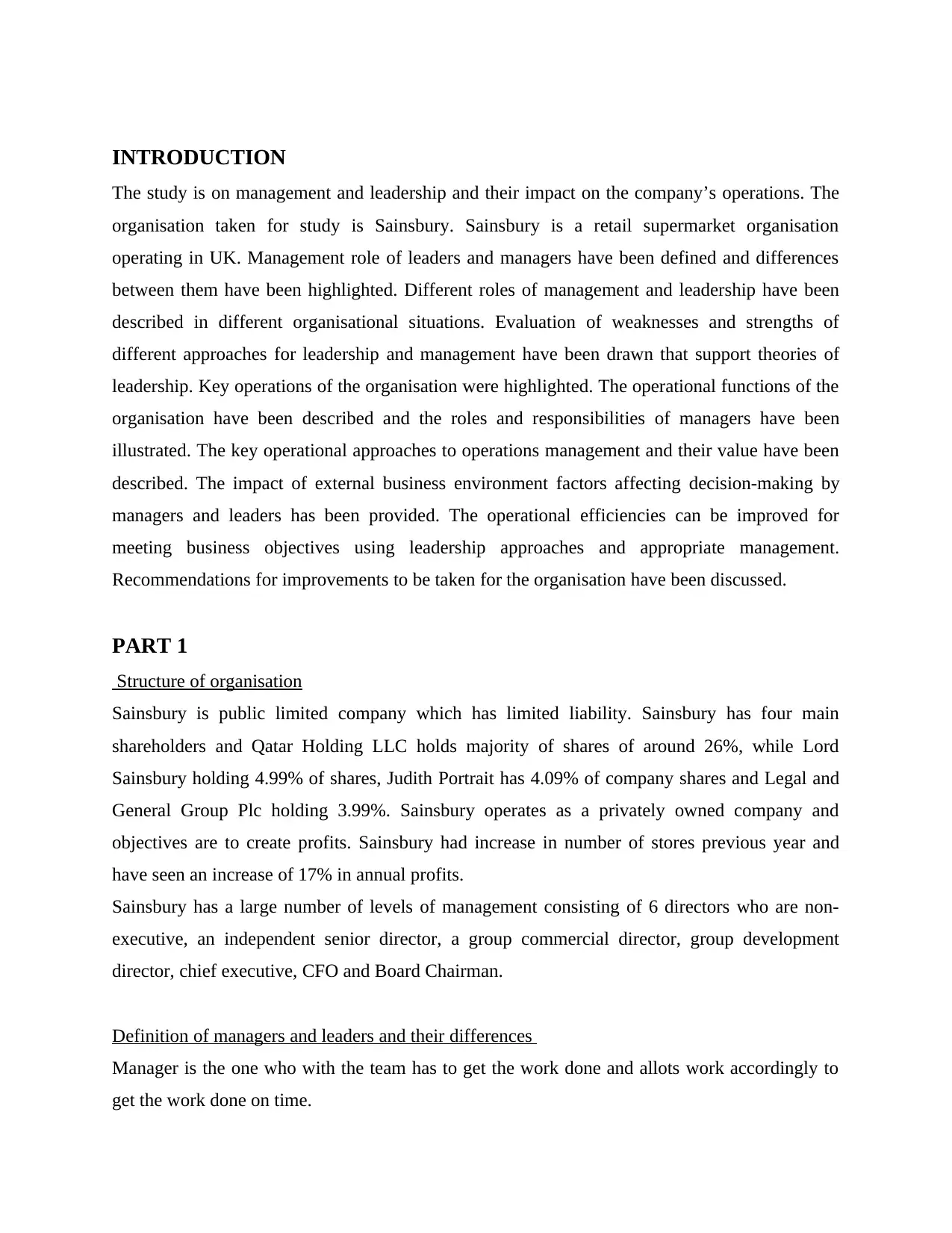
INTRODUCTION
The study is on management and leadership and their impact on the company’s operations. The
organisation taken for study is Sainsbury. Sainsbury is a retail supermarket organisation
operating in UK. Management role of leaders and managers have been defined and differences
between them have been highlighted. Different roles of management and leadership have been
described in different organisational situations. Evaluation of weaknesses and strengths of
different approaches for leadership and management have been drawn that support theories of
leadership. Key operations of the organisation were highlighted. The operational functions of the
organisation have been described and the roles and responsibilities of managers have been
illustrated. The key operational approaches to operations management and their value have been
described. The impact of external business environment factors affecting decision-making by
managers and leaders has been provided. The operational efficiencies can be improved for
meeting business objectives using leadership approaches and appropriate management.
Recommendations for improvements to be taken for the organisation have been discussed.
PART 1
Structure of organisation
Sainsbury is public limited company which has limited liability. Sainsbury has four main
shareholders and Qatar Holding LLC holds majority of shares of around 26%, while Lord
Sainsbury holding 4.99% of shares, Judith Portrait has 4.09% of company shares and Legal and
General Group Plc holding 3.99%. Sainsbury operates as a privately owned company and
objectives are to create profits. Sainsbury had increase in number of stores previous year and
have seen an increase of 17% in annual profits.
Sainsbury has a large number of levels of management consisting of 6 directors who are non-
executive, an independent senior director, a group commercial director, group development
director, chief executive, CFO and Board Chairman.
Definition of managers and leaders and their differences
Manager is the one who with the team has to get the work done and allots work accordingly to
get the work done on time.
The study is on management and leadership and their impact on the company’s operations. The
organisation taken for study is Sainsbury. Sainsbury is a retail supermarket organisation
operating in UK. Management role of leaders and managers have been defined and differences
between them have been highlighted. Different roles of management and leadership have been
described in different organisational situations. Evaluation of weaknesses and strengths of
different approaches for leadership and management have been drawn that support theories of
leadership. Key operations of the organisation were highlighted. The operational functions of the
organisation have been described and the roles and responsibilities of managers have been
illustrated. The key operational approaches to operations management and their value have been
described. The impact of external business environment factors affecting decision-making by
managers and leaders has been provided. The operational efficiencies can be improved for
meeting business objectives using leadership approaches and appropriate management.
Recommendations for improvements to be taken for the organisation have been discussed.
PART 1
Structure of organisation
Sainsbury is public limited company which has limited liability. Sainsbury has four main
shareholders and Qatar Holding LLC holds majority of shares of around 26%, while Lord
Sainsbury holding 4.99% of shares, Judith Portrait has 4.09% of company shares and Legal and
General Group Plc holding 3.99%. Sainsbury operates as a privately owned company and
objectives are to create profits. Sainsbury had increase in number of stores previous year and
have seen an increase of 17% in annual profits.
Sainsbury has a large number of levels of management consisting of 6 directors who are non-
executive, an independent senior director, a group commercial director, group development
director, chief executive, CFO and Board Chairman.
Definition of managers and leaders and their differences
Manager is the one who with the team has to get the work done and allots work accordingly to
get the work done on time.
⊘ This is a preview!⊘
Do you want full access?
Subscribe today to unlock all pages.

Trusted by 1+ million students worldwide
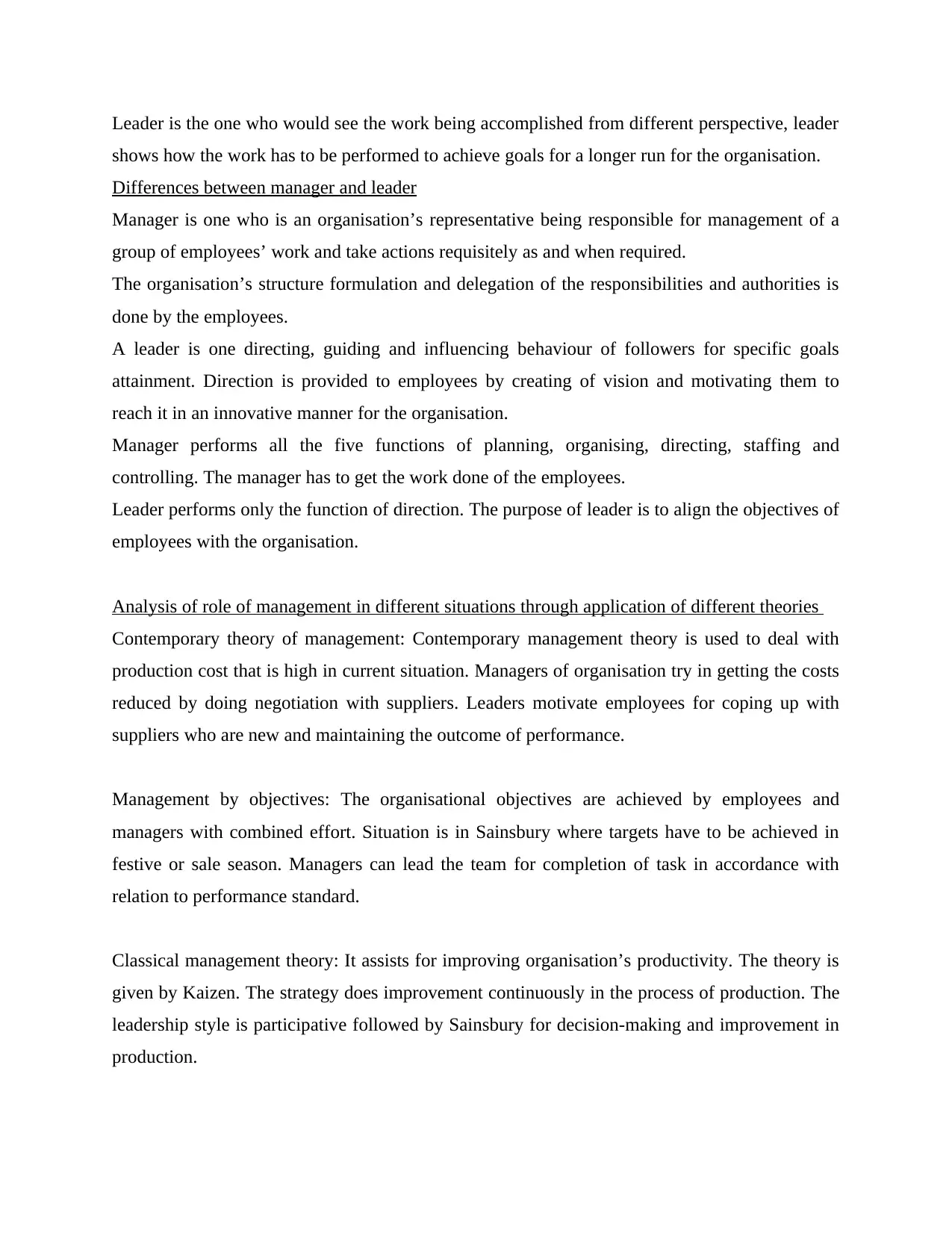
Leader is the one who would see the work being accomplished from different perspective, leader
shows how the work has to be performed to achieve goals for a longer run for the organisation.
Differences between manager and leader
Manager is one who is an organisation’s representative being responsible for management of a
group of employees’ work and take actions requisitely as and when required.
The organisation’s structure formulation and delegation of the responsibilities and authorities is
done by the employees.
A leader is one directing, guiding and influencing behaviour of followers for specific goals
attainment. Direction is provided to employees by creating of vision and motivating them to
reach it in an innovative manner for the organisation.
Manager performs all the five functions of planning, organising, directing, staffing and
controlling. The manager has to get the work done of the employees.
Leader performs only the function of direction. The purpose of leader is to align the objectives of
employees with the organisation.
Analysis of role of management in different situations through application of different theories
Contemporary theory of management: Contemporary management theory is used to deal with
production cost that is high in current situation. Managers of organisation try in getting the costs
reduced by doing negotiation with suppliers. Leaders motivate employees for coping up with
suppliers who are new and maintaining the outcome of performance.
Management by objectives: The organisational objectives are achieved by employees and
managers with combined effort. Situation is in Sainsbury where targets have to be achieved in
festive or sale season. Managers can lead the team for completion of task in accordance with
relation to performance standard.
Classical management theory: It assists for improving organisation’s productivity. The theory is
given by Kaizen. The strategy does improvement continuously in the process of production. The
leadership style is participative followed by Sainsbury for decision-making and improvement in
production.
shows how the work has to be performed to achieve goals for a longer run for the organisation.
Differences between manager and leader
Manager is one who is an organisation’s representative being responsible for management of a
group of employees’ work and take actions requisitely as and when required.
The organisation’s structure formulation and delegation of the responsibilities and authorities is
done by the employees.
A leader is one directing, guiding and influencing behaviour of followers for specific goals
attainment. Direction is provided to employees by creating of vision and motivating them to
reach it in an innovative manner for the organisation.
Manager performs all the five functions of planning, organising, directing, staffing and
controlling. The manager has to get the work done of the employees.
Leader performs only the function of direction. The purpose of leader is to align the objectives of
employees with the organisation.
Analysis of role of management in different situations through application of different theories
Contemporary theory of management: Contemporary management theory is used to deal with
production cost that is high in current situation. Managers of organisation try in getting the costs
reduced by doing negotiation with suppliers. Leaders motivate employees for coping up with
suppliers who are new and maintaining the outcome of performance.
Management by objectives: The organisational objectives are achieved by employees and
managers with combined effort. Situation is in Sainsbury where targets have to be achieved in
festive or sale season. Managers can lead the team for completion of task in accordance with
relation to performance standard.
Classical management theory: It assists for improving organisation’s productivity. The theory is
given by Kaizen. The strategy does improvement continuously in the process of production. The
leadership style is participative followed by Sainsbury for decision-making and improvement in
production.
Paraphrase This Document
Need a fresh take? Get an instant paraphrase of this document with our AI Paraphraser
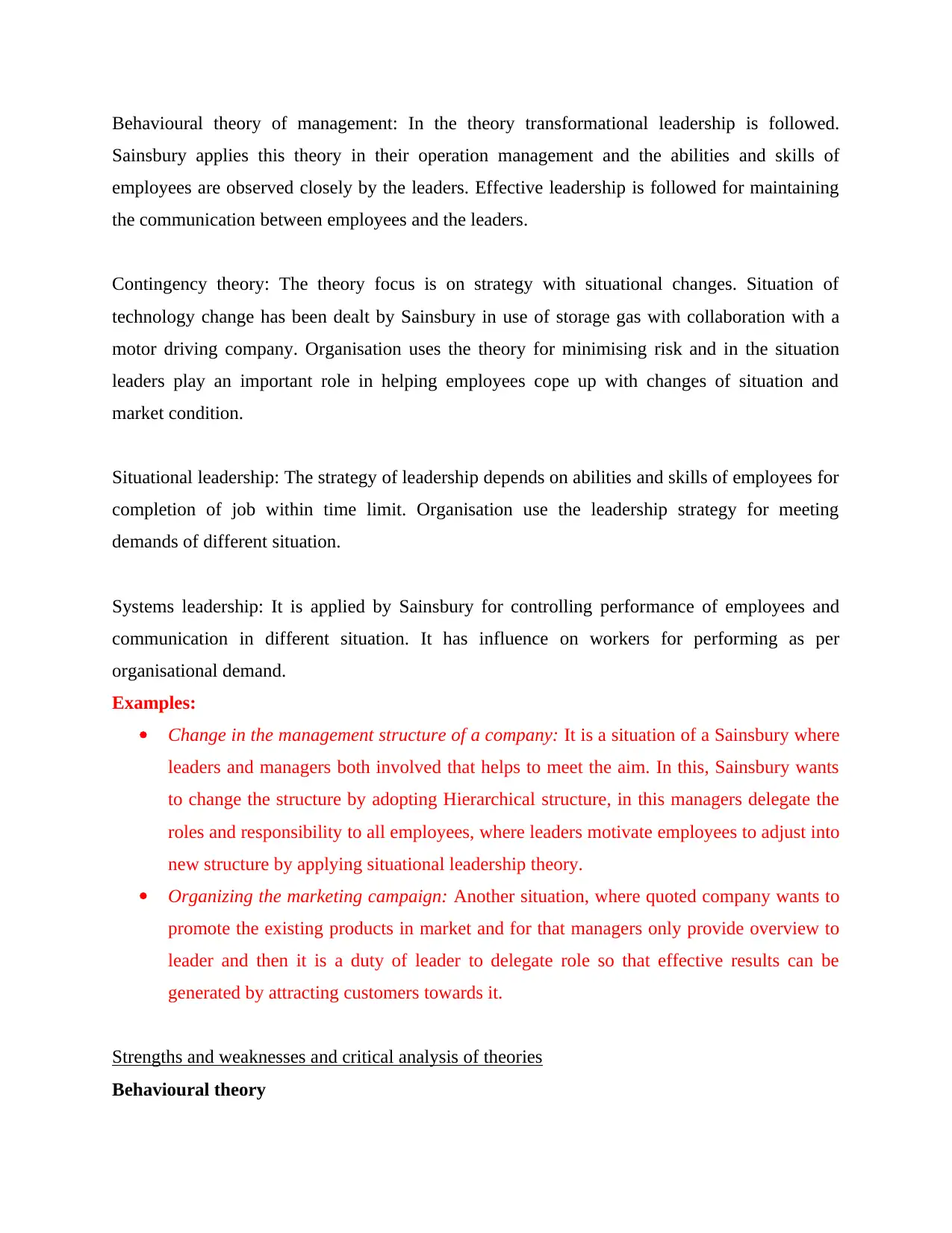
Behavioural theory of management: In the theory transformational leadership is followed.
Sainsbury applies this theory in their operation management and the abilities and skills of
employees are observed closely by the leaders. Effective leadership is followed for maintaining
the communication between employees and the leaders.
Contingency theory: The theory focus is on strategy with situational changes. Situation of
technology change has been dealt by Sainsbury in use of storage gas with collaboration with a
motor driving company. Organisation uses the theory for minimising risk and in the situation
leaders play an important role in helping employees cope up with changes of situation and
market condition.
Situational leadership: The strategy of leadership depends on abilities and skills of employees for
completion of job within time limit. Organisation use the leadership strategy for meeting
demands of different situation.
Systems leadership: It is applied by Sainsbury for controlling performance of employees and
communication in different situation. It has influence on workers for performing as per
organisational demand.
Examples:
Change in the management structure of a company: It is a situation of a Sainsbury where
leaders and managers both involved that helps to meet the aim. In this, Sainsbury wants
to change the structure by adopting Hierarchical structure, in this managers delegate the
roles and responsibility to all employees, where leaders motivate employees to adjust into
new structure by applying situational leadership theory.
Organizing the marketing campaign: Another situation, where quoted company wants to
promote the existing products in market and for that managers only provide overview to
leader and then it is a duty of leader to delegate role so that effective results can be
generated by attracting customers towards it.
Strengths and weaknesses and critical analysis of theories
Behavioural theory
Sainsbury applies this theory in their operation management and the abilities and skills of
employees are observed closely by the leaders. Effective leadership is followed for maintaining
the communication between employees and the leaders.
Contingency theory: The theory focus is on strategy with situational changes. Situation of
technology change has been dealt by Sainsbury in use of storage gas with collaboration with a
motor driving company. Organisation uses the theory for minimising risk and in the situation
leaders play an important role in helping employees cope up with changes of situation and
market condition.
Situational leadership: The strategy of leadership depends on abilities and skills of employees for
completion of job within time limit. Organisation use the leadership strategy for meeting
demands of different situation.
Systems leadership: It is applied by Sainsbury for controlling performance of employees and
communication in different situation. It has influence on workers for performing as per
organisational demand.
Examples:
Change in the management structure of a company: It is a situation of a Sainsbury where
leaders and managers both involved that helps to meet the aim. In this, Sainsbury wants
to change the structure by adopting Hierarchical structure, in this managers delegate the
roles and responsibility to all employees, where leaders motivate employees to adjust into
new structure by applying situational leadership theory.
Organizing the marketing campaign: Another situation, where quoted company wants to
promote the existing products in market and for that managers only provide overview to
leader and then it is a duty of leader to delegate role so that effective results can be
generated by attracting customers towards it.
Strengths and weaknesses and critical analysis of theories
Behavioural theory
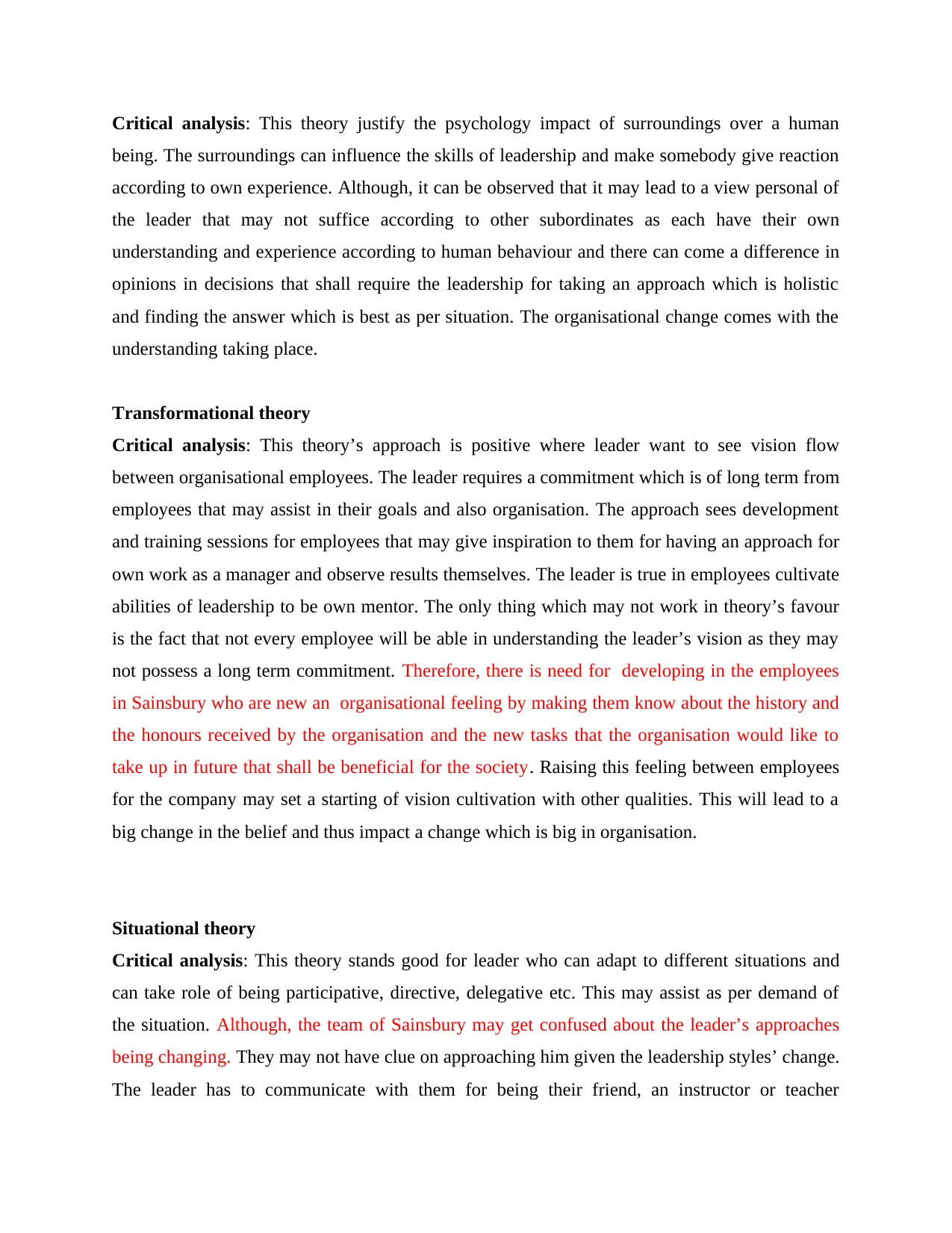
Critical analysis: This theory justify the psychology impact of surroundings over a human
being. The surroundings can influence the skills of leadership and make somebody give reaction
according to own experience. Although, it can be observed that it may lead to a view personal of
the leader that may not suffice according to other subordinates as each have their own
understanding and experience according to human behaviour and there can come a difference in
opinions in decisions that shall require the leadership for taking an approach which is holistic
and finding the answer which is best as per situation. The organisational change comes with the
understanding taking place.
Transformational theory
Critical analysis: This theory’s approach is positive where leader want to see vision flow
between organisational employees. The leader requires a commitment which is of long term from
employees that may assist in their goals and also organisation. The approach sees development
and training sessions for employees that may give inspiration to them for having an approach for
own work as a manager and observe results themselves. The leader is true in employees cultivate
abilities of leadership to be own mentor. The only thing which may not work in theory’s favour
is the fact that not every employee will be able in understanding the leader’s vision as they may
not possess a long term commitment. Therefore, there is need for developing in the employees
in Sainsbury who are new an organisational feeling by making them know about the history and
the honours received by the organisation and the new tasks that the organisation would like to
take up in future that shall be beneficial for the society. Raising this feeling between employees
for the company may set a starting of vision cultivation with other qualities. This will lead to a
big change in the belief and thus impact a change which is big in organisation.
Situational theory
Critical analysis: This theory stands good for leader who can adapt to different situations and
can take role of being participative, directive, delegative etc. This may assist as per demand of
the situation. Although, the team of Sainsbury may get confused about the leader’s approaches
being changing. They may not have clue on approaching him given the leadership styles’ change.
The leader has to communicate with them for being their friend, an instructor or teacher
being. The surroundings can influence the skills of leadership and make somebody give reaction
according to own experience. Although, it can be observed that it may lead to a view personal of
the leader that may not suffice according to other subordinates as each have their own
understanding and experience according to human behaviour and there can come a difference in
opinions in decisions that shall require the leadership for taking an approach which is holistic
and finding the answer which is best as per situation. The organisational change comes with the
understanding taking place.
Transformational theory
Critical analysis: This theory’s approach is positive where leader want to see vision flow
between organisational employees. The leader requires a commitment which is of long term from
employees that may assist in their goals and also organisation. The approach sees development
and training sessions for employees that may give inspiration to them for having an approach for
own work as a manager and observe results themselves. The leader is true in employees cultivate
abilities of leadership to be own mentor. The only thing which may not work in theory’s favour
is the fact that not every employee will be able in understanding the leader’s vision as they may
not possess a long term commitment. Therefore, there is need for developing in the employees
in Sainsbury who are new an organisational feeling by making them know about the history and
the honours received by the organisation and the new tasks that the organisation would like to
take up in future that shall be beneficial for the society. Raising this feeling between employees
for the company may set a starting of vision cultivation with other qualities. This will lead to a
big change in the belief and thus impact a change which is big in organisation.
Situational theory
Critical analysis: This theory stands good for leader who can adapt to different situations and
can take role of being participative, directive, delegative etc. This may assist as per demand of
the situation. Although, the team of Sainsbury may get confused about the leader’s approaches
being changing. They may not have clue on approaching him given the leadership styles’ change.
The leader has to communicate with them for being their friend, an instructor or teacher
⊘ This is a preview!⊘
Do you want full access?
Subscribe today to unlock all pages.

Trusted by 1+ million students worldwide
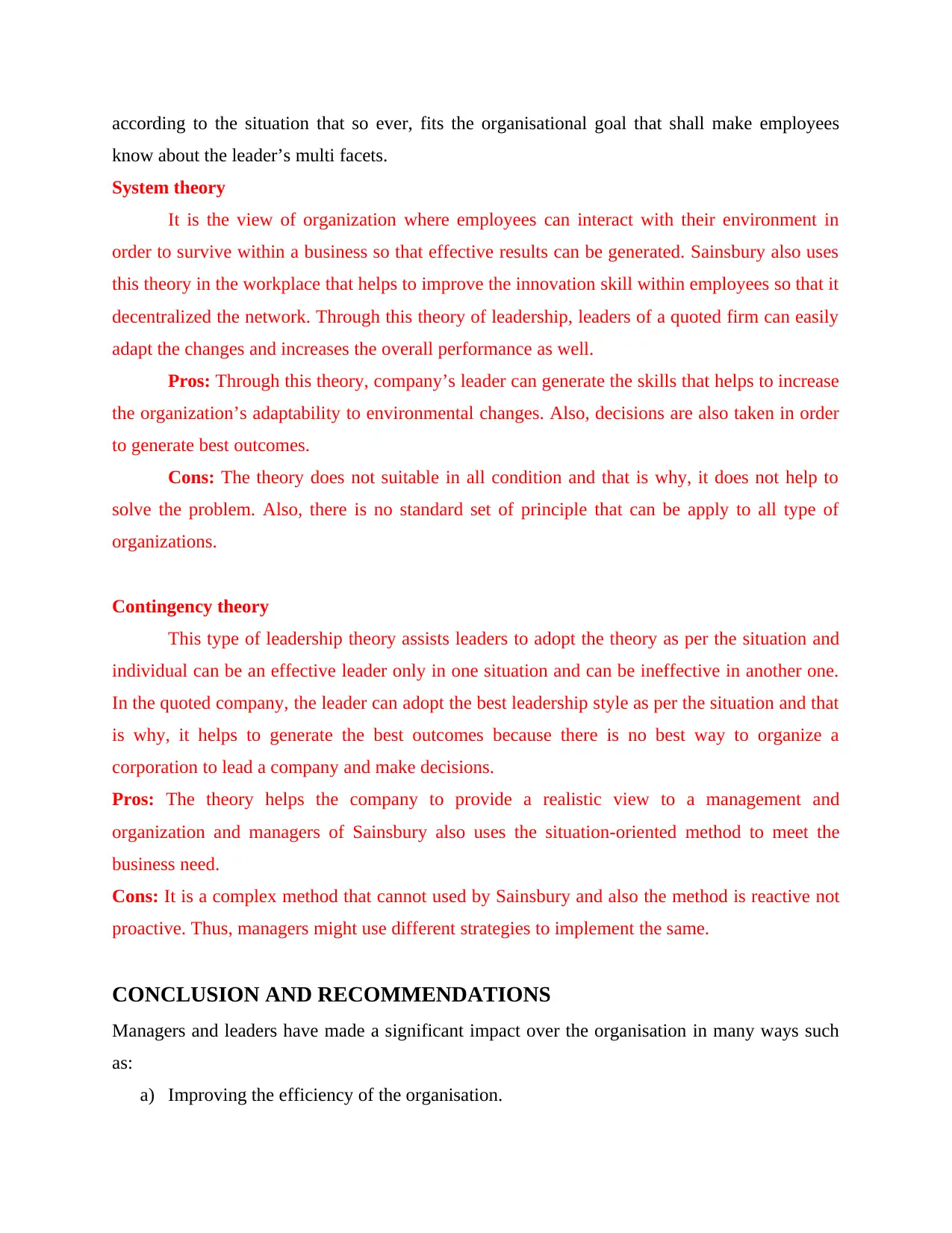
according to the situation that so ever, fits the organisational goal that shall make employees
know about the leader’s multi facets.
System theory
It is the view of organization where employees can interact with their environment in
order to survive within a business so that effective results can be generated. Sainsbury also uses
this theory in the workplace that helps to improve the innovation skill within employees so that it
decentralized the network. Through this theory of leadership, leaders of a quoted firm can easily
adapt the changes and increases the overall performance as well.
Pros: Through this theory, company’s leader can generate the skills that helps to increase
the organization’s adaptability to environmental changes. Also, decisions are also taken in order
to generate best outcomes.
Cons: The theory does not suitable in all condition and that is why, it does not help to
solve the problem. Also, there is no standard set of principle that can be apply to all type of
organizations.
Contingency theory
This type of leadership theory assists leaders to adopt the theory as per the situation and
individual can be an effective leader only in one situation and can be ineffective in another one.
In the quoted company, the leader can adopt the best leadership style as per the situation and that
is why, it helps to generate the best outcomes because there is no best way to organize a
corporation to lead a company and make decisions.
Pros: The theory helps the company to provide a realistic view to a management and
organization and managers of Sainsbury also uses the situation-oriented method to meet the
business need.
Cons: It is a complex method that cannot used by Sainsbury and also the method is reactive not
proactive. Thus, managers might use different strategies to implement the same.
CONCLUSION AND RECOMMENDATIONS
Managers and leaders have made a significant impact over the organisation in many ways such
as:
a) Improving the efficiency of the organisation.
know about the leader’s multi facets.
System theory
It is the view of organization where employees can interact with their environment in
order to survive within a business so that effective results can be generated. Sainsbury also uses
this theory in the workplace that helps to improve the innovation skill within employees so that it
decentralized the network. Through this theory of leadership, leaders of a quoted firm can easily
adapt the changes and increases the overall performance as well.
Pros: Through this theory, company’s leader can generate the skills that helps to increase
the organization’s adaptability to environmental changes. Also, decisions are also taken in order
to generate best outcomes.
Cons: The theory does not suitable in all condition and that is why, it does not help to
solve the problem. Also, there is no standard set of principle that can be apply to all type of
organizations.
Contingency theory
This type of leadership theory assists leaders to adopt the theory as per the situation and
individual can be an effective leader only in one situation and can be ineffective in another one.
In the quoted company, the leader can adopt the best leadership style as per the situation and that
is why, it helps to generate the best outcomes because there is no best way to organize a
corporation to lead a company and make decisions.
Pros: The theory helps the company to provide a realistic view to a management and
organization and managers of Sainsbury also uses the situation-oriented method to meet the
business need.
Cons: It is a complex method that cannot used by Sainsbury and also the method is reactive not
proactive. Thus, managers might use different strategies to implement the same.
CONCLUSION AND RECOMMENDATIONS
Managers and leaders have made a significant impact over the organisation in many ways such
as:
a) Improving the efficiency of the organisation.
Paraphrase This Document
Need a fresh take? Get an instant paraphrase of this document with our AI Paraphraser
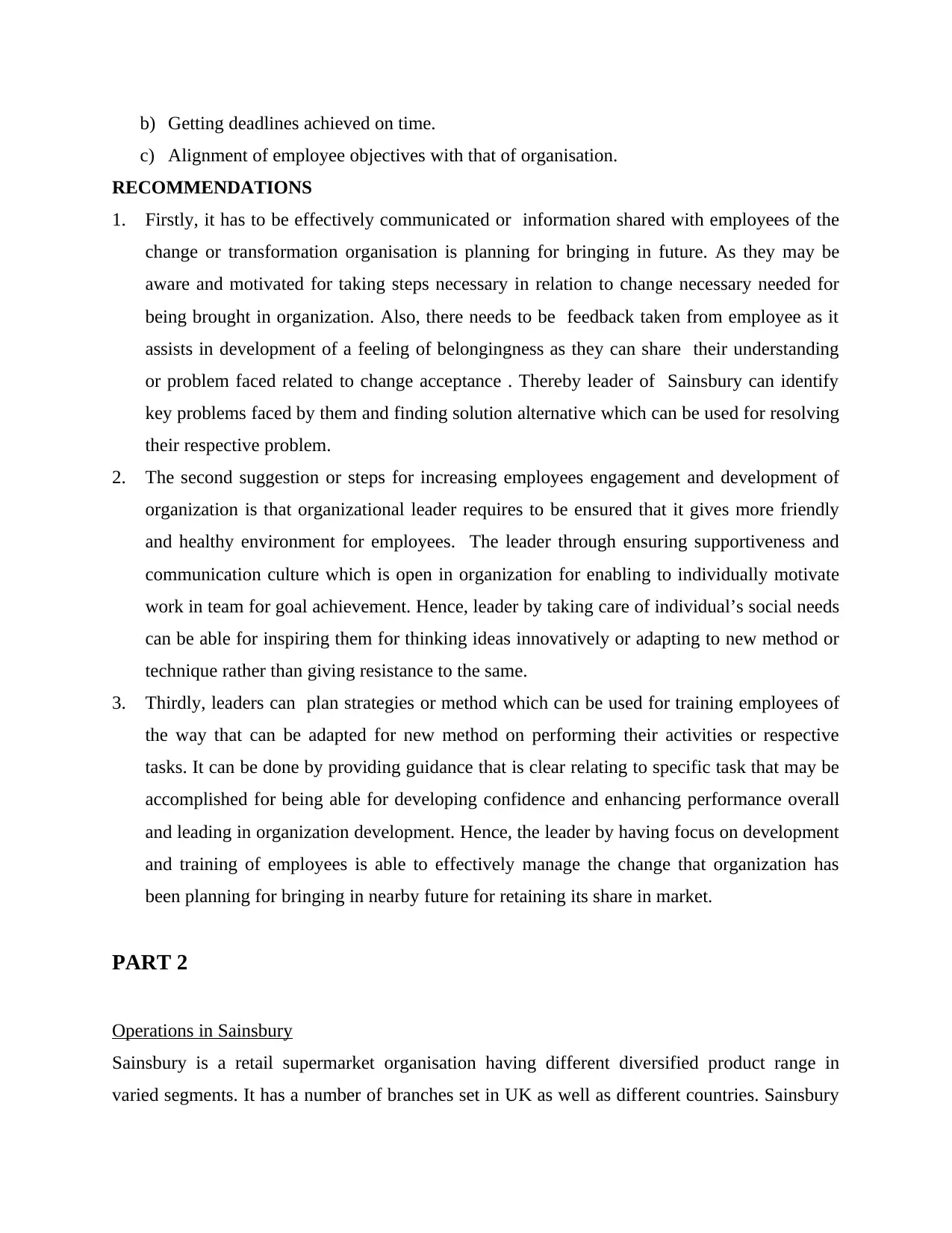
b) Getting deadlines achieved on time.
c) Alignment of employee objectives with that of organisation.
RECOMMENDATIONS
1. Firstly, it has to be effectively communicated or information shared with employees of the
change or transformation organisation is planning for bringing in future. As they may be
aware and motivated for taking steps necessary in relation to change necessary needed for
being brought in organization. Also, there needs to be feedback taken from employee as it
assists in development of a feeling of belongingness as they can share their understanding
or problem faced related to change acceptance . Thereby leader of Sainsbury can identify
key problems faced by them and finding solution alternative which can be used for resolving
their respective problem.
2. The second suggestion or steps for increasing employees engagement and development of
organization is that organizational leader requires to be ensured that it gives more friendly
and healthy environment for employees. The leader through ensuring supportiveness and
communication culture which is open in organization for enabling to individually motivate
work in team for goal achievement. Hence, leader by taking care of individual’s social needs
can be able for inspiring them for thinking ideas innovatively or adapting to new method or
technique rather than giving resistance to the same.
3. Thirdly, leaders can plan strategies or method which can be used for training employees of
the way that can be adapted for new method on performing their activities or respective
tasks. It can be done by providing guidance that is clear relating to specific task that may be
accomplished for being able for developing confidence and enhancing performance overall
and leading in organization development. Hence, the leader by having focus on development
and training of employees is able to effectively manage the change that organization has
been planning for bringing in nearby future for retaining its share in market.
PART 2
Operations in Sainsbury
Sainsbury is a retail supermarket organisation having different diversified product range in
varied segments. It has a number of branches set in UK as well as different countries. Sainsbury
c) Alignment of employee objectives with that of organisation.
RECOMMENDATIONS
1. Firstly, it has to be effectively communicated or information shared with employees of the
change or transformation organisation is planning for bringing in future. As they may be
aware and motivated for taking steps necessary in relation to change necessary needed for
being brought in organization. Also, there needs to be feedback taken from employee as it
assists in development of a feeling of belongingness as they can share their understanding
or problem faced related to change acceptance . Thereby leader of Sainsbury can identify
key problems faced by them and finding solution alternative which can be used for resolving
their respective problem.
2. The second suggestion or steps for increasing employees engagement and development of
organization is that organizational leader requires to be ensured that it gives more friendly
and healthy environment for employees. The leader through ensuring supportiveness and
communication culture which is open in organization for enabling to individually motivate
work in team for goal achievement. Hence, leader by taking care of individual’s social needs
can be able for inspiring them for thinking ideas innovatively or adapting to new method or
technique rather than giving resistance to the same.
3. Thirdly, leaders can plan strategies or method which can be used for training employees of
the way that can be adapted for new method on performing their activities or respective
tasks. It can be done by providing guidance that is clear relating to specific task that may be
accomplished for being able for developing confidence and enhancing performance overall
and leading in organization development. Hence, the leader by having focus on development
and training of employees is able to effectively manage the change that organization has
been planning for bringing in nearby future for retaining its share in market.
PART 2
Operations in Sainsbury
Sainsbury is a retail supermarket organisation having different diversified product range in
varied segments. It has a number of branches set in UK as well as different countries. Sainsbury
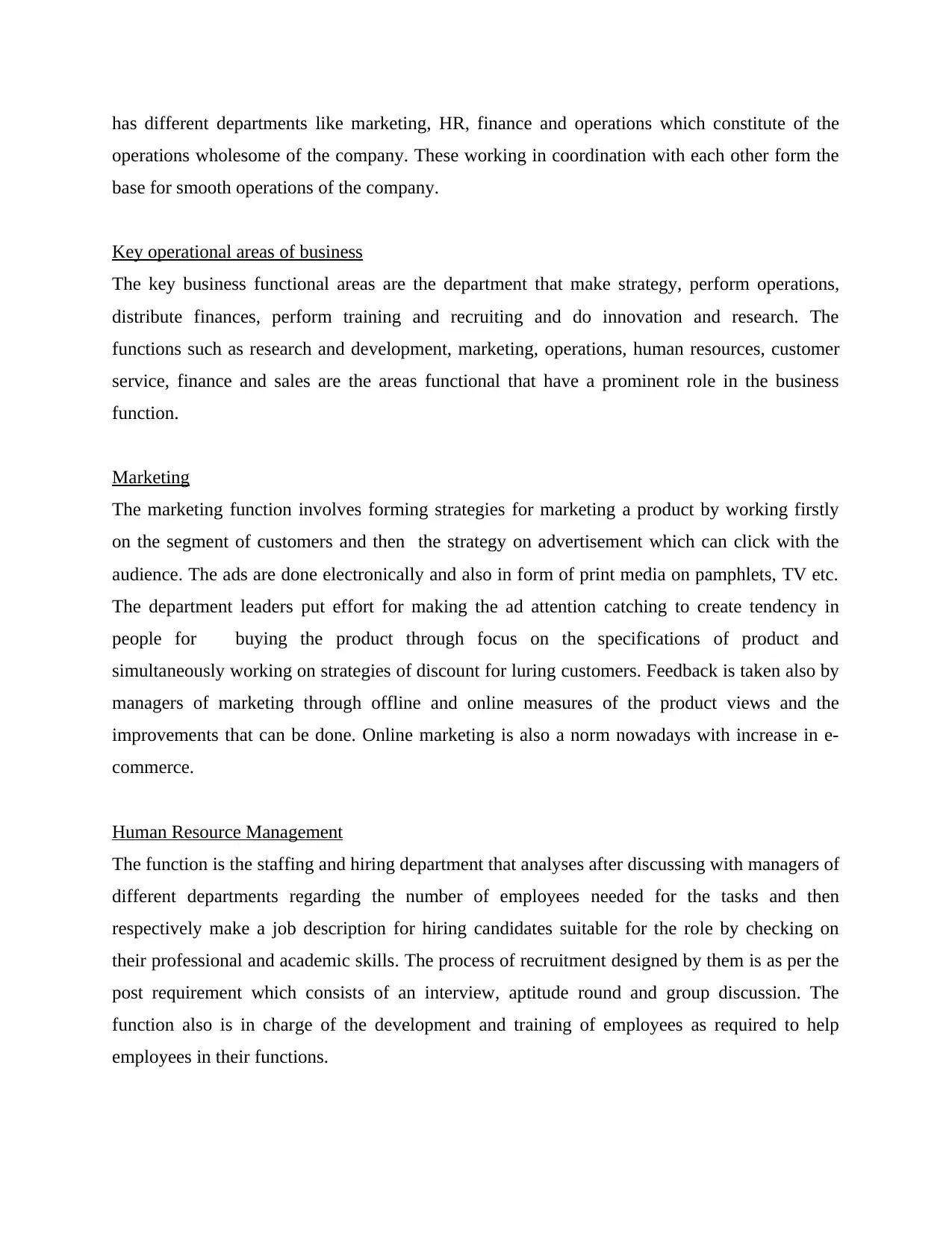
has different departments like marketing, HR, finance and operations which constitute of the
operations wholesome of the company. These working in coordination with each other form the
base for smooth operations of the company.
Key operational areas of business
The key business functional areas are the department that make strategy, perform operations,
distribute finances, perform training and recruiting and do innovation and research. The
functions such as research and development, marketing, operations, human resources, customer
service, finance and sales are the areas functional that have a prominent role in the business
function.
Marketing
The marketing function involves forming strategies for marketing a product by working firstly
on the segment of customers and then the strategy on advertisement which can click with the
audience. The ads are done electronically and also in form of print media on pamphlets, TV etc.
The department leaders put effort for making the ad attention catching to create tendency in
people for buying the product through focus on the specifications of product and
simultaneously working on strategies of discount for luring customers. Feedback is taken also by
managers of marketing through offline and online measures of the product views and the
improvements that can be done. Online marketing is also a norm nowadays with increase in e-
commerce.
Human Resource Management
The function is the staffing and hiring department that analyses after discussing with managers of
different departments regarding the number of employees needed for the tasks and then
respectively make a job description for hiring candidates suitable for the role by checking on
their professional and academic skills. The process of recruitment designed by them is as per the
post requirement which consists of an interview, aptitude round and group discussion. The
function also is in charge of the development and training of employees as required to help
employees in their functions.
operations wholesome of the company. These working in coordination with each other form the
base for smooth operations of the company.
Key operational areas of business
The key business functional areas are the department that make strategy, perform operations,
distribute finances, perform training and recruiting and do innovation and research. The
functions such as research and development, marketing, operations, human resources, customer
service, finance and sales are the areas functional that have a prominent role in the business
function.
Marketing
The marketing function involves forming strategies for marketing a product by working firstly
on the segment of customers and then the strategy on advertisement which can click with the
audience. The ads are done electronically and also in form of print media on pamphlets, TV etc.
The department leaders put effort for making the ad attention catching to create tendency in
people for buying the product through focus on the specifications of product and
simultaneously working on strategies of discount for luring customers. Feedback is taken also by
managers of marketing through offline and online measures of the product views and the
improvements that can be done. Online marketing is also a norm nowadays with increase in e-
commerce.
Human Resource Management
The function is the staffing and hiring department that analyses after discussing with managers of
different departments regarding the number of employees needed for the tasks and then
respectively make a job description for hiring candidates suitable for the role by checking on
their professional and academic skills. The process of recruitment designed by them is as per the
post requirement which consists of an interview, aptitude round and group discussion. The
function also is in charge of the development and training of employees as required to help
employees in their functions.
⊘ This is a preview!⊘
Do you want full access?
Subscribe today to unlock all pages.

Trusted by 1+ million students worldwide
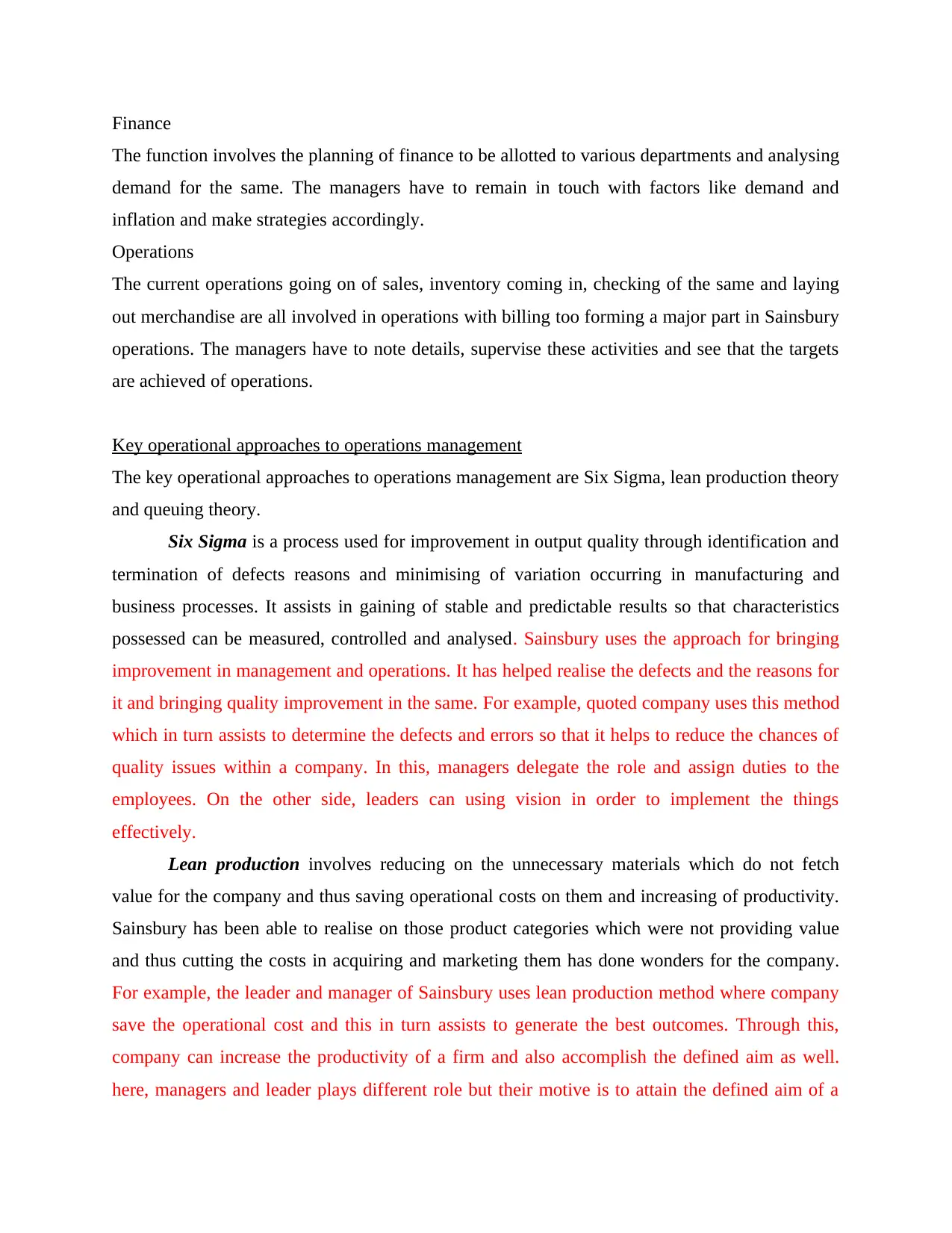
Finance
The function involves the planning of finance to be allotted to various departments and analysing
demand for the same. The managers have to remain in touch with factors like demand and
inflation and make strategies accordingly.
Operations
The current operations going on of sales, inventory coming in, checking of the same and laying
out merchandise are all involved in operations with billing too forming a major part in Sainsbury
operations. The managers have to note details, supervise these activities and see that the targets
are achieved of operations.
Key operational approaches to operations management
The key operational approaches to operations management are Six Sigma, lean production theory
and queuing theory.
Six Sigma is a process used for improvement in output quality through identification and
termination of defects reasons and minimising of variation occurring in manufacturing and
business processes. It assists in gaining of stable and predictable results so that characteristics
possessed can be measured, controlled and analysed. Sainsbury uses the approach for bringing
improvement in management and operations. It has helped realise the defects and the reasons for
it and bringing quality improvement in the same. For example, quoted company uses this method
which in turn assists to determine the defects and errors so that it helps to reduce the chances of
quality issues within a company. In this, managers delegate the role and assign duties to the
employees. On the other side, leaders can using vision in order to implement the things
effectively.
Lean production involves reducing on the unnecessary materials which do not fetch
value for the company and thus saving operational costs on them and increasing of productivity.
Sainsbury has been able to realise on those product categories which were not providing value
and thus cutting the costs in acquiring and marketing them has done wonders for the company.
For example, the leader and manager of Sainsbury uses lean production method where company
save the operational cost and this in turn assists to generate the best outcomes. Through this,
company can increase the productivity of a firm and also accomplish the defined aim as well.
here, managers and leader plays different role but their motive is to attain the defined aim of a
The function involves the planning of finance to be allotted to various departments and analysing
demand for the same. The managers have to remain in touch with factors like demand and
inflation and make strategies accordingly.
Operations
The current operations going on of sales, inventory coming in, checking of the same and laying
out merchandise are all involved in operations with billing too forming a major part in Sainsbury
operations. The managers have to note details, supervise these activities and see that the targets
are achieved of operations.
Key operational approaches to operations management
The key operational approaches to operations management are Six Sigma, lean production theory
and queuing theory.
Six Sigma is a process used for improvement in output quality through identification and
termination of defects reasons and minimising of variation occurring in manufacturing and
business processes. It assists in gaining of stable and predictable results so that characteristics
possessed can be measured, controlled and analysed. Sainsbury uses the approach for bringing
improvement in management and operations. It has helped realise the defects and the reasons for
it and bringing quality improvement in the same. For example, quoted company uses this method
which in turn assists to determine the defects and errors so that it helps to reduce the chances of
quality issues within a company. In this, managers delegate the role and assign duties to the
employees. On the other side, leaders can using vision in order to implement the things
effectively.
Lean production involves reducing on the unnecessary materials which do not fetch
value for the company and thus saving operational costs on them and increasing of productivity.
Sainsbury has been able to realise on those product categories which were not providing value
and thus cutting the costs in acquiring and marketing them has done wonders for the company.
For example, the leader and manager of Sainsbury uses lean production method where company
save the operational cost and this in turn assists to generate the best outcomes. Through this,
company can increase the productivity of a firm and also accomplish the defined aim as well.
here, managers and leader plays different role but their motive is to attain the defined aim of a
Paraphrase This Document
Need a fresh take? Get an instant paraphrase of this document with our AI Paraphraser
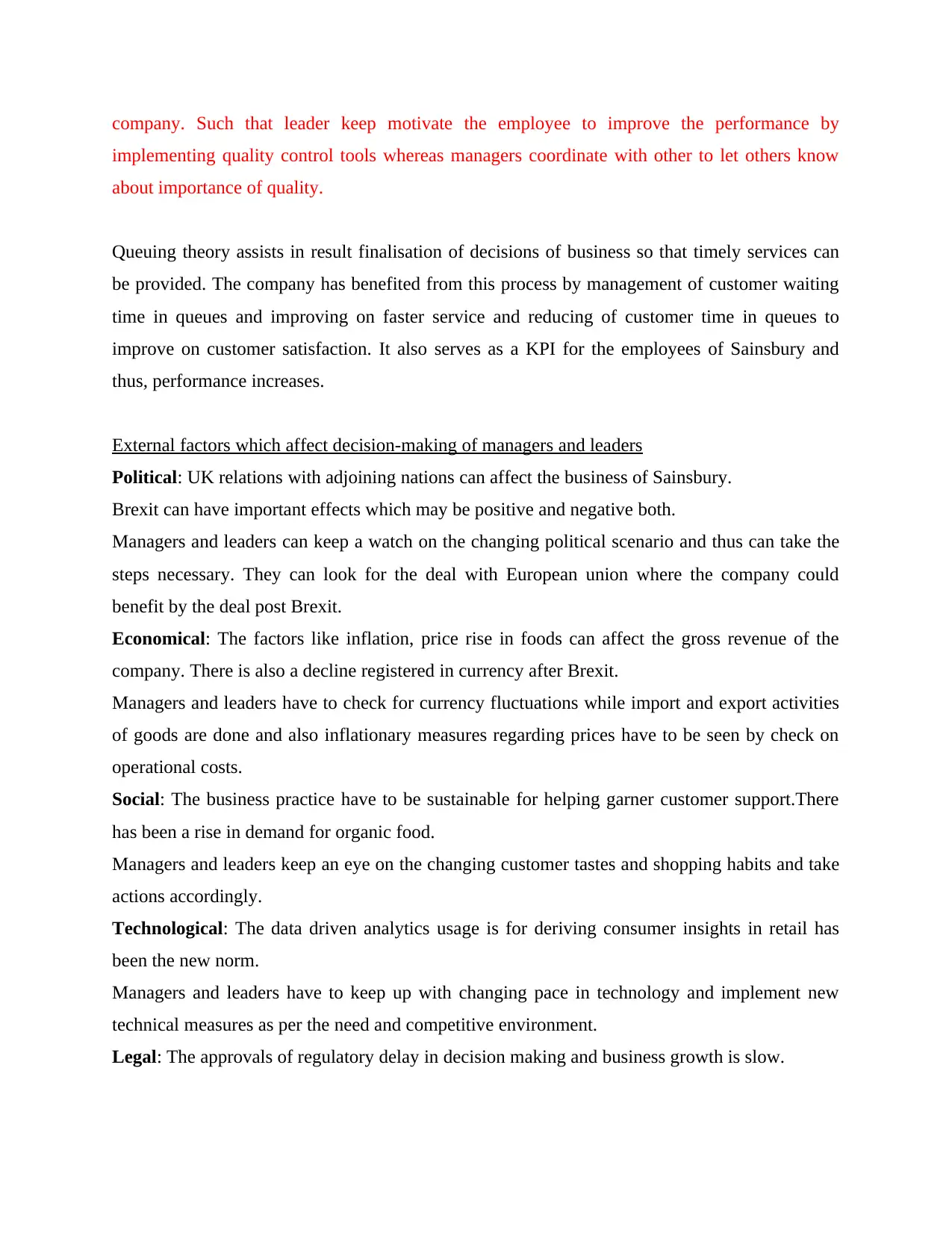
company. Such that leader keep motivate the employee to improve the performance by
implementing quality control tools whereas managers coordinate with other to let others know
about importance of quality.
Queuing theory assists in result finalisation of decisions of business so that timely services can
be provided. The company has benefited from this process by management of customer waiting
time in queues and improving on faster service and reducing of customer time in queues to
improve on customer satisfaction. It also serves as a KPI for the employees of Sainsbury and
thus, performance increases.
External factors which affect decision-making of managers and leaders
Political: UK relations with adjoining nations can affect the business of Sainsbury.
Brexit can have important effects which may be positive and negative both.
Managers and leaders can keep a watch on the changing political scenario and thus can take the
steps necessary. They can look for the deal with European union where the company could
benefit by the deal post Brexit.
Economical: The factors like inflation, price rise in foods can affect the gross revenue of the
company. There is also a decline registered in currency after Brexit.
Managers and leaders have to check for currency fluctuations while import and export activities
of goods are done and also inflationary measures regarding prices have to be seen by check on
operational costs.
Social: The business practice have to be sustainable for helping garner customer support.There
has been a rise in demand for organic food.
Managers and leaders keep an eye on the changing customer tastes and shopping habits and take
actions accordingly.
Technological: The data driven analytics usage is for deriving consumer insights in retail has
been the new norm.
Managers and leaders have to keep up with changing pace in technology and implement new
technical measures as per the need and competitive environment.
Legal: The approvals of regulatory delay in decision making and business growth is slow.
implementing quality control tools whereas managers coordinate with other to let others know
about importance of quality.
Queuing theory assists in result finalisation of decisions of business so that timely services can
be provided. The company has benefited from this process by management of customer waiting
time in queues and improving on faster service and reducing of customer time in queues to
improve on customer satisfaction. It also serves as a KPI for the employees of Sainsbury and
thus, performance increases.
External factors which affect decision-making of managers and leaders
Political: UK relations with adjoining nations can affect the business of Sainsbury.
Brexit can have important effects which may be positive and negative both.
Managers and leaders can keep a watch on the changing political scenario and thus can take the
steps necessary. They can look for the deal with European union where the company could
benefit by the deal post Brexit.
Economical: The factors like inflation, price rise in foods can affect the gross revenue of the
company. There is also a decline registered in currency after Brexit.
Managers and leaders have to check for currency fluctuations while import and export activities
of goods are done and also inflationary measures regarding prices have to be seen by check on
operational costs.
Social: The business practice have to be sustainable for helping garner customer support.There
has been a rise in demand for organic food.
Managers and leaders keep an eye on the changing customer tastes and shopping habits and take
actions accordingly.
Technological: The data driven analytics usage is for deriving consumer insights in retail has
been the new norm.
Managers and leaders have to keep up with changing pace in technology and implement new
technical measures as per the need and competitive environment.
Legal: The approvals of regulatory delay in decision making and business growth is slow.
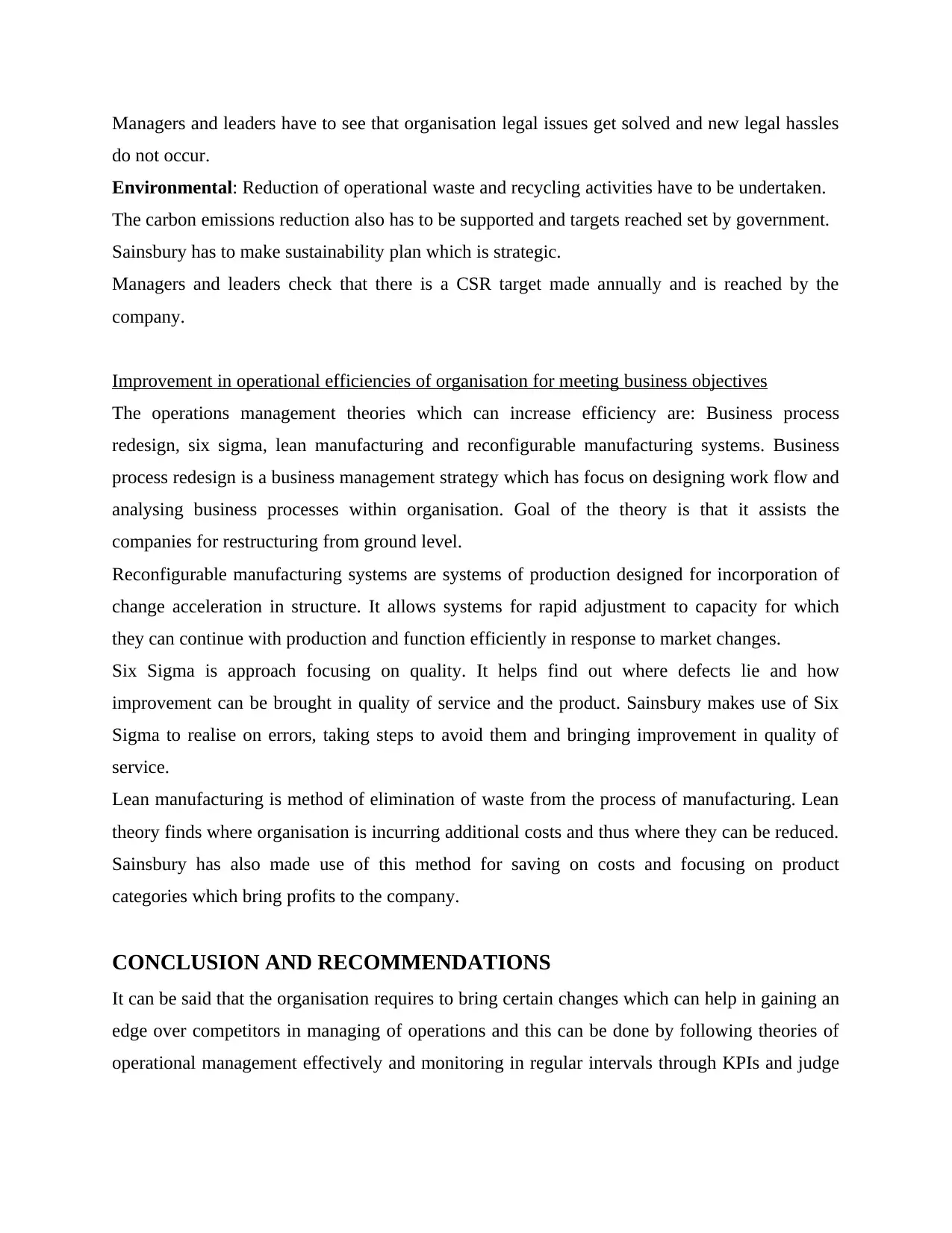
Managers and leaders have to see that organisation legal issues get solved and new legal hassles
do not occur.
Environmental: Reduction of operational waste and recycling activities have to be undertaken.
The carbon emissions reduction also has to be supported and targets reached set by government.
Sainsbury has to make sustainability plan which is strategic.
Managers and leaders check that there is a CSR target made annually and is reached by the
company.
Improvement in operational efficiencies of organisation for meeting business objectives
The operations management theories which can increase efficiency are: Business process
redesign, six sigma, lean manufacturing and reconfigurable manufacturing systems. Business
process redesign is a business management strategy which has focus on designing work flow and
analysing business processes within organisation. Goal of the theory is that it assists the
companies for restructuring from ground level.
Reconfigurable manufacturing systems are systems of production designed for incorporation of
change acceleration in structure. It allows systems for rapid adjustment to capacity for which
they can continue with production and function efficiently in response to market changes.
Six Sigma is approach focusing on quality. It helps find out where defects lie and how
improvement can be brought in quality of service and the product. Sainsbury makes use of Six
Sigma to realise on errors, taking steps to avoid them and bringing improvement in quality of
service.
Lean manufacturing is method of elimination of waste from the process of manufacturing. Lean
theory finds where organisation is incurring additional costs and thus where they can be reduced.
Sainsbury has also made use of this method for saving on costs and focusing on product
categories which bring profits to the company.
CONCLUSION AND RECOMMENDATIONS
It can be said that the organisation requires to bring certain changes which can help in gaining an
edge over competitors in managing of operations and this can be done by following theories of
operational management effectively and monitoring in regular intervals through KPIs and judge
do not occur.
Environmental: Reduction of operational waste and recycling activities have to be undertaken.
The carbon emissions reduction also has to be supported and targets reached set by government.
Sainsbury has to make sustainability plan which is strategic.
Managers and leaders check that there is a CSR target made annually and is reached by the
company.
Improvement in operational efficiencies of organisation for meeting business objectives
The operations management theories which can increase efficiency are: Business process
redesign, six sigma, lean manufacturing and reconfigurable manufacturing systems. Business
process redesign is a business management strategy which has focus on designing work flow and
analysing business processes within organisation. Goal of the theory is that it assists the
companies for restructuring from ground level.
Reconfigurable manufacturing systems are systems of production designed for incorporation of
change acceleration in structure. It allows systems for rapid adjustment to capacity for which
they can continue with production and function efficiently in response to market changes.
Six Sigma is approach focusing on quality. It helps find out where defects lie and how
improvement can be brought in quality of service and the product. Sainsbury makes use of Six
Sigma to realise on errors, taking steps to avoid them and bringing improvement in quality of
service.
Lean manufacturing is method of elimination of waste from the process of manufacturing. Lean
theory finds where organisation is incurring additional costs and thus where they can be reduced.
Sainsbury has also made use of this method for saving on costs and focusing on product
categories which bring profits to the company.
CONCLUSION AND RECOMMENDATIONS
It can be said that the organisation requires to bring certain changes which can help in gaining an
edge over competitors in managing of operations and this can be done by following theories of
operational management effectively and monitoring in regular intervals through KPIs and judge
⊘ This is a preview!⊘
Do you want full access?
Subscribe today to unlock all pages.

Trusted by 1+ million students worldwide
1 out of 23
Related Documents
Your All-in-One AI-Powered Toolkit for Academic Success.
+13062052269
info@desklib.com
Available 24*7 on WhatsApp / Email
![[object Object]](/_next/static/media/star-bottom.7253800d.svg)
Unlock your academic potential
Copyright © 2020–2025 A2Z Services. All Rights Reserved. Developed and managed by ZUCOL.




